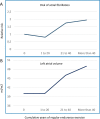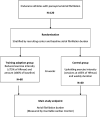Effects of training adaption in endurance athletes with atrial fibrillation: protocol for a multicentre randomised controlled trial
- PMID: 37073174
- PMCID: PMC10106028
- DOI: 10.1136/bmjsem-2023-001541
Effects of training adaption in endurance athletes with atrial fibrillation: protocol for a multicentre randomised controlled trial
Abstract
Endurance athletes have a high prevalence of atrial fibrillation (AF), probably caused by exercise-induced cardiac remodelling. Athletes diagnosed with AF are often advised to reduce the intensity and amount of training but the efficacy of this intervention has not been investigated in endurance athletes with AF. Effects of detraining in endurance athletes with atrial fibrillation is a two-arm international multicentre randomised (1:1) controlled trial on the effects of a period of training adaption on AF burden in endurance athletes with paroxysmal AF. One-hundred-and-twenty endurance athletes diagnosed with paroxysmal AF are randomised to a 16-week period of intervention (training adaption) or a control group. We define training adaption as training with a heart rate (HR) not exceeding 75% of the individual maximum HR (HRmax), and total duration of weekly training not exceeding 80% of the self-reported average before the study. The control group is instructed to uphold training intensity including sessions with HR ≥85% of HRmax. AF burden is monitored with insertable cardiac monitors, and training intensity with HR chest-straps and connected sports watches. The primary endpoint, AF burden, will be calculated as the cumulative duration of all AF episodes lasting ≥30sec divided by total duration of monitoring. Secondary endpoints include number of AF episodes, adherence to training adaption, exercise capacity, AF symptoms and health-related quality of life, echocardiographic signs of cardiac remodelling and risk of cardiac arrhythmias related to upholding training intensity.
Trial registration number: NCT04991337.
Study protocol version: 4.7 (Date 9 March 2023).
Keywords: Athlete; Cardiology; Endurance; Exercise; Sports medicine.
© Author(s) (or their employer(s)) 2023. Re-use permitted under CC BY-NC. No commercial re-use. See rights and permissions. Published by BMJ.
Conflict of interest statement
Competing interests: None declared.
Figures



References
Associated data
LinkOut - more resources
Full Text Sources
Medical
